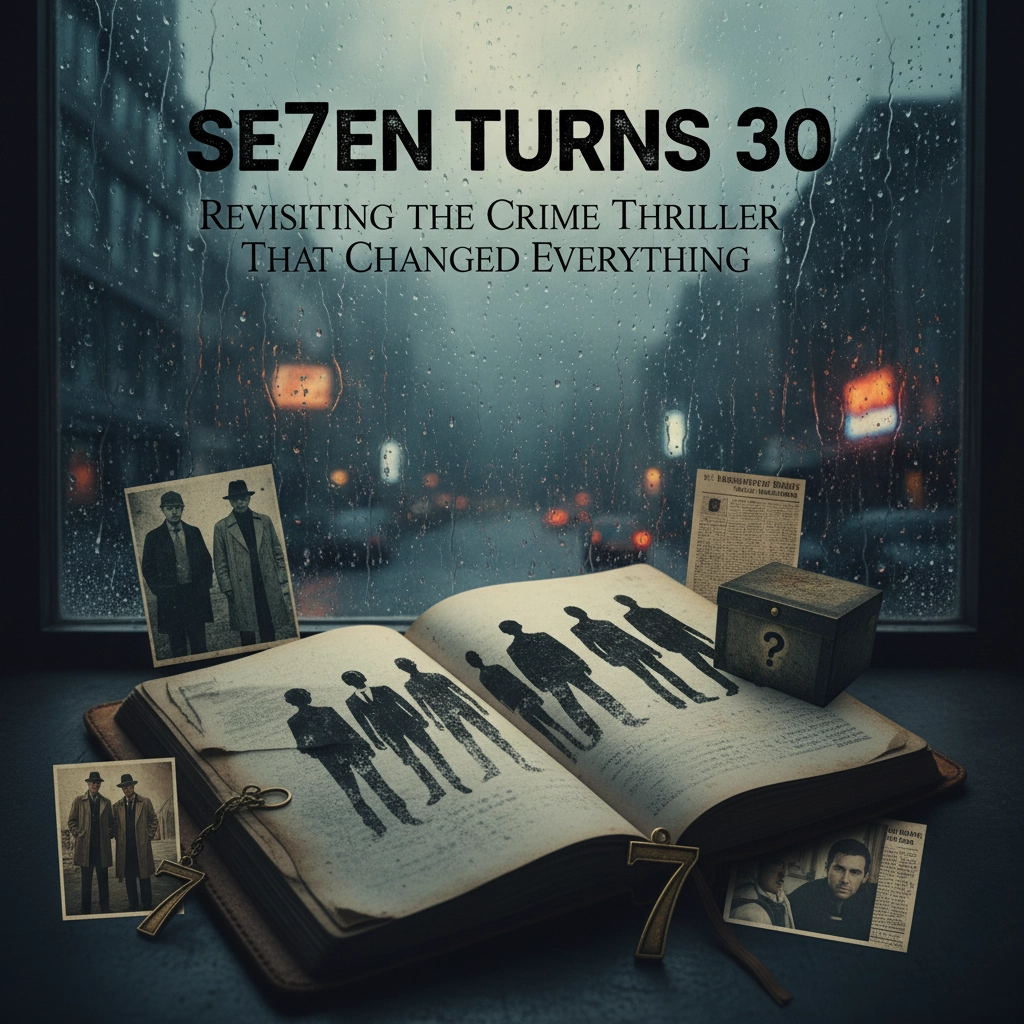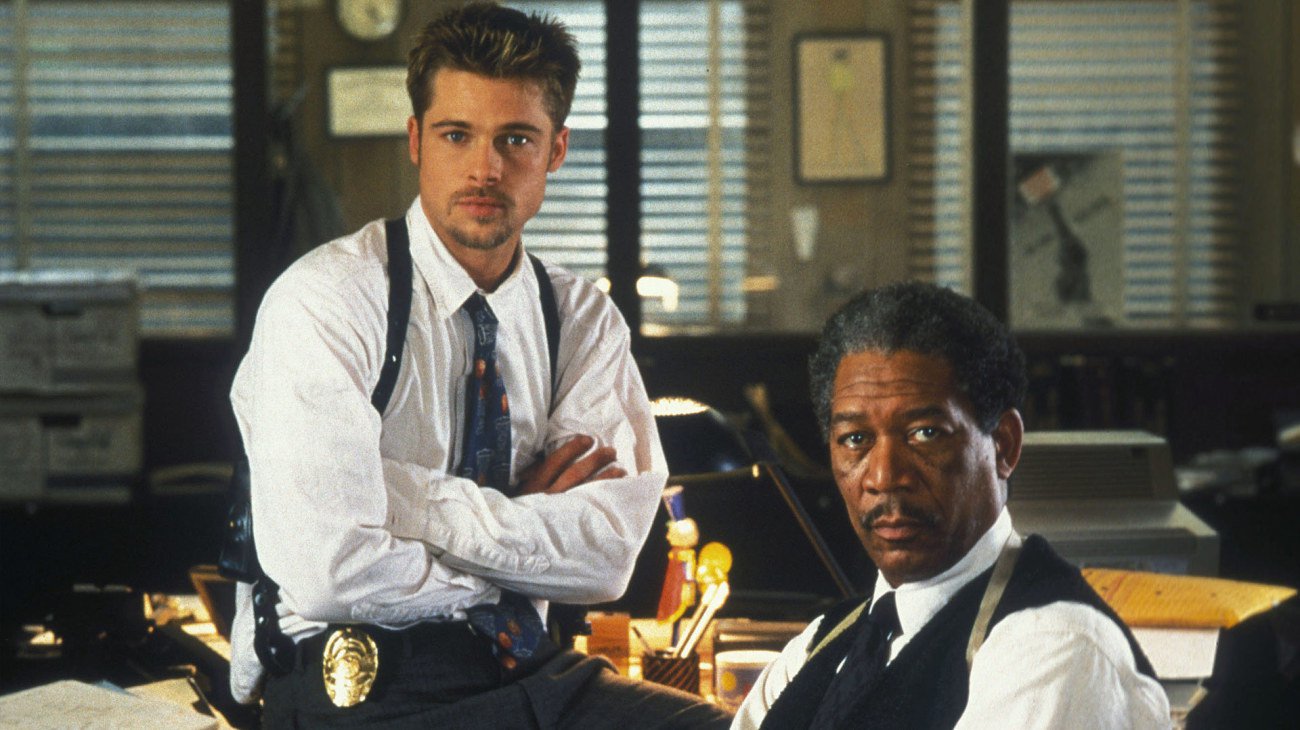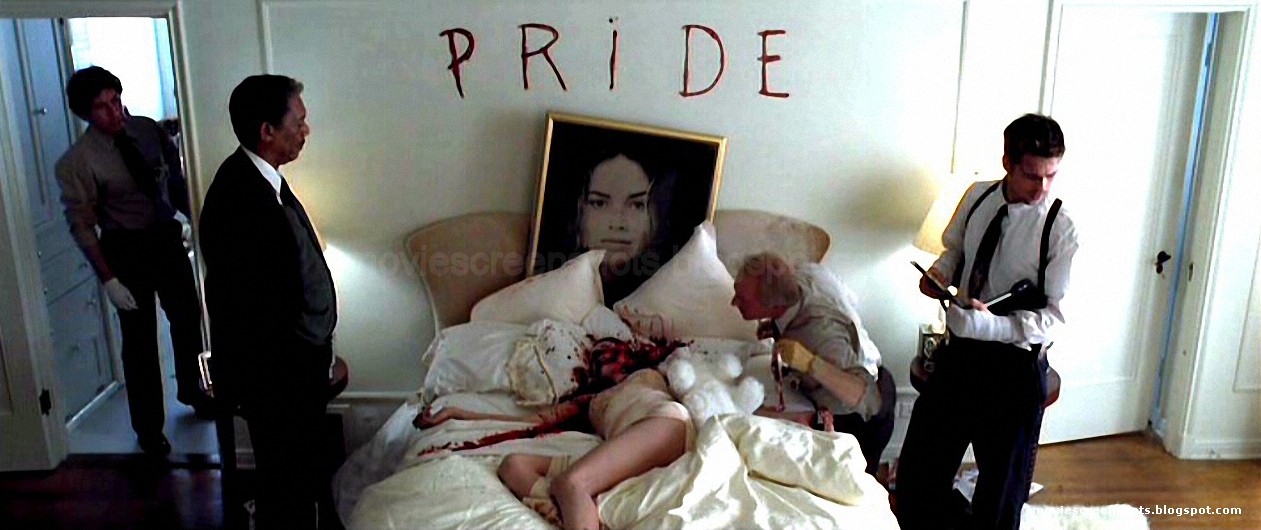
Se7en Turns 30: Revisiting the Crime Thriller That Changed Everything.Thirty years ago this September, David Fincher unleashed something genuinely unsettling into theaters. Se7en wasn’t just another crime thriller: it was a pitch-black meditation on human nature that refused to offer comfort or easy answers. As we mark three decades since its release on September 22, 1995, the film’s uncompromising vision feels more relevant than ever in our increasingly cynical world.
While other thrillers of the mid-90s were content with formulaic cat-and-mouse games, Se7en dared to ask uncomfortable questions about society’s moral fabric. The result was a masterpiece that redefined what crime cinema could be: and audiences are still trying to process its implications today.
When Darkness Became Art
Se7en follows two mismatched detectives in an unnamed, perpetually rain-soaked city. Veteran Lieutenant William Somerset (Morgan Freeman) is counting down his final days before retirement, worn down by decades of witnessing humanity’s worst impulses. His replacement, Detective David Mills (Brad Pitt), arrives with the kind of idealistic energy that Somerset has long since abandoned.
Their partnership begins with a gruesome discovery: an obese man forced to eat himself to death. It’s the first in a series of elaborate murders, each designed to represent one of the seven deadly sins. What starts as a typical serial killer investigation transforms into something far more disturbing: a philosophical war between a methodical madman and the very concept of justice itself.

The killer, who identifies himself only as “John Doe” (Kevin Spacey), isn’t interested in random violence. His murders are sermons delivered through suffering, each victim chosen to embody a particular sin. The gluttonous man represents the obvious choice, followed by a greedy defense attorney who dies in a scene too disturbing to fully describe here.
As Somerset and Mills dig deeper, they realize they’re not just chasing a killer: they’re being led through a carefully orchestrated performance piece where they’ve been cast as unwilling participants.
The Seven Deadly Sins as Structure
What made Se7en revolutionary was its use of the seven deadly sins not as mere gimmicks, but as a genuine philosophical framework. Each murder represents more than just John Doe’s twisted creativity: they’re indictments of a society that has lost its moral compass.
The sin of pride becomes particularly haunting in retrospect. A beautiful model is given the choice between calling for help with a disfigured face or taking her own life. She chooses death, and Doe’s point about vanity and self-image cuts deeper than any knife could.

Sloth takes the form of a man who’s been kept barely alive for exactly one year, strapped to a bed in conditions so horrific that when the detectives find him, they initially assume he’s dead. The victim’s survival becomes almost more disturbing than his death would have been.
Each sin builds upon the last, creating a crescendo of horror that serves a larger purpose. Doe isn’t just killing people: he’s creating a treatise on human failing, with each murder serving as both evidence and argument.
The Ending That Changed Everything
Then comes the ending that audiences still debate three decades later. With only two sins remaining: envy and wrath: John Doe walks into the police station covered in blood and surrenders. He offers to lead the detectives to the final two bodies, but only if Somerset and Mills come alone.
What follows is cinema’s most devastating game of psychological chess. In a remote desert location, a delivery truck arrives with a package for Mills. Inside the box: though we never see it: is the head of Mills’ wife Tracy (Gwyneth Paltrow). Doe reveals that he represents envy, having coveted Mills’ normal life, and now Mills must choose whether to become wrath by killing Doe in revenge.
Furthermore, the genius of this ending isn’t its shock value: it’s how perfectly it completes the film’s thematic argument. Mills, the idealistic cop who believed in justice and doing the right thing, ultimately becomes the very thing he’s been fighting against. Doe wins not through superior firepower or clever escapes, but by proving his fundamental point about human nature.

Fincher’s Unnamed City of Despair
David Fincher’s direction creates an atmosphere so oppressive it becomes a character itself. The unnamed city where Se7en takes place exists in perpetual twilight, where rain falls constantly and sunlight never penetrates the urban decay. This isn’t just stylistic choice: it’s environmental storytelling at its finest.
The city’s anonymity is crucial. This could be anywhere, which makes it everywhere. Fincher and cinematographer Darius Khondji created a visual language of decay and moral rot that permeates every frame. The color palette drains warmth from every scene, leaving viewers feeling as exhausted and hopeless as Somerset himself.
This visual approach influenced countless films that followed. The dark, desaturated look of Se7en can be seen in everything from Zodiac to The Dark Knight, proving that Fincher had tapped into something fundamental about how modern audiences wanted their urban nightmares presented.

Themes That Won’t Go Away
Se7en‘s exploration of moral decay and societal apathy feels disturbingly prescient thirty years later. The film argues that society has become so numb to suffering and injustice that only the most extreme acts can pierce through our collective indifference. John Doe positions himself as a wake-up call, forcing people to confront sins they’ve learned to ignore.
The movie’s treatment of media and celebrity culture also feels eerily contemporary. When Doe’s crimes become public, they’re transformed into entertainment. The killer’s philosophical motivations get lost in sensational coverage, proving his point about society’s inability to engage with serious moral questions.
Somerset’s world-weariness represents the exhaustion of anyone who’s tried to maintain ethical standards in an increasingly complex world. His famous question: “What’s in the box?”: has become shorthand for dreading the answer to questions we’re afraid to ask.
Genre-Defining Impact
Se7en didn’t just succeed commercially and critically: it fundamentally altered what audiences expected from crime thrillers. The film grossed over $327 million worldwide and proved that audiences were hungry for challenging, uncompromising narratives.
In the three decades since, countless films have attempted to capture Se7en‘s lightning in a bottle. The influence can be seen in everything from The Silence of the Lambs sequels to modern streaming series like Mindhunter (also directed by Fincher). The template of methodical killers with philosophical motivations has become so common it’s almost cliché: but none have matched the original’s perfect synthesis of style and substance.
Embraced Dark Themes.
The film also established David Fincher as a major directorial voice. His meticulous attention to detail, willingness to explore dark themes, and refusal to provide easy answers became his trademark. Se7en was the announcement that a new kind of filmmaker had arrived: one unafraid to hold up a mirror to society’s ugliest aspects.

Why It Still Resonates
Thirty years later, Se7en remains unsettlingly relevant because its central concerns: moral decay, societal indifference, and the corruption of idealism: haven’t gone anywhere. If anything, they’ve intensified. In an age of social media, 24-hour news cycles, and increasing polarization, John Doe’s critique of modern society feels more urgent than ever.
The film’s refusal to provide cathartic resolution continues to frustrate and fascinate viewers. Mills’ transformation into wrath doesn’t feel like justice: it feels like tragedy. Somerset’s decision to stay on the force suggests hope, but it’s the thinnest possible hope in a world that seems determined to disappoint.
Seven Respected it’s Audience.
Se7en endures because it respects its audience’s intelligence while never letting them off the hook emotionally. It’s a film that trusts viewers to grapple with complex moral questions without providing easy answers. In our current era of simplified narratives and binary thinking, that kind of moral complexity feels both rare and essential.
As we mark thirty years since Se7en first disturbed audiences, its power remains undiminished. The film stands as a testament to what crime cinema can achieve when it aims higher than mere entertainment: when it dares to examine the darkness within us all and ask what we’re willing to do about it.
The box is still there, and we’re still afraid to look inside.
